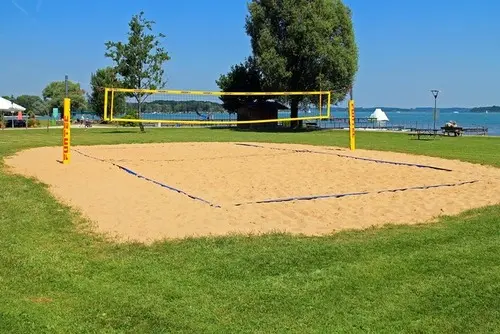Volleyball Court Dimensions and Layout

Volleyball Court Dimensions and Layout: A Detailed Guide
Volleyball is a fast paced, dynamic sport enjoyed by millions worldwide. Whether played recreationally in a park or competitively in an indoor arena, understanding the proper court dimensions and layout is essential for players, referees and coaches.
This guide will take you through the standard volleyball court dimensions, markings and key elements of the layout, ensuring you have a thorough understanding of the playing area.
Official Volleyball Court Dimensions
The dimensions of a volleyball court are standardized by international governing bodies like the Fédération Internationale de Volleyball (FIVB) and the National Collegiate Athletic Association (NCAA). Here are the essential measurements for a standard volleyball court:
- Total Court Size: 18 meters (59 feet) long by 9 meters (29.5 feet) wide.
- Half Court Dimensions: Each team’s playing area is 9 meters (29.5 feet) long and 9 meters (29.5 feet) wide.
The court is divided in half by a centerline and each side is a mirror image of the other. These dimensions apply to both indoor and beach volleyball, although the surrounding free space and some other markings vary between the two.
Free Zone and Overhead Clearance
- Free Zone: The free zone is the area surrounding the court where players can move to play the ball. For indoor volleyball, the free zone should be a minimum of 3 meters (10 feet) wide on all sides. In international competitions, this space can extend up to 5 meters (16.5 feet) on the sidelines and 6.5 meters (21 feet) behind the end lines.
- Overhead Clearance: A minimum of 7 meters (23 feet) of unobstructed space above the playing surface is required for indoor volleyball. In competitive play, the overhead clearance should be at least 12.5 meters (41 feet).
Markings and Lines on a Volleyball Court
Volleyball courts have several essential markings that define various zones and positions for gameplay. Each line on the court has a specific purpose and helps ensure fair play.
Boundary Lines
- Sidelines: The two longest lines that run the length of the court (18 meters / 59 feet). They mark the outer edges of the court.
- End Lines (Baselines): The two shorter lines at each end of the court (9 meters / 29.5 feet). They mark the back boundaries.
Centerline
- The centerline divides the court into two equal halves. It runs directly under the net and measures the full width of the court (9 meters / 29.5 feet).
Attack Line (3 meter Line)
- The attack line, also known as the 3 meter line or 10 foot line, is drawn parallel to the centerline and is located 3 meters (10 feet) back from the net on each side of the court. This line is crucial for distinguishing between front row and back row players during an attack.
Service Area
- The service area is located behind each end line. It is 9 meters (29.5 feet) wide and extends 2 meters (6.5 feet) back from the end line. The server must remain within this area when serving the ball.
Substitution Zone
- The substitution zone is located between the attack line and the centerline on the sideline. This is the area where players enter and exit the court during substitutions.
Libero Replacement Zone
- The libero replacement zone is a special area located between the attack line and the end line. It allows the libero (a specialized defensive player) to substitute in and out without formal substitution procedures.
Net Height and Structure
The net plays a critical role in volleyball and its height varies based on the gender and age group of the players. Here are the official net heights:
- Men’s Net Height: 2.43 meters (7 feet, 11 5/8 inches)
- Women’s Net Height: 2.24 meters (7 feet, 4 1/8 inches)
- Boys (16 and Under): 2.24 meters (7 feet, 4 1/8 inches)
- Girls (16 and Under): 2.13 meters (7 feet)
The net is 1 meter (3 feet, 3 inches) wide and extends the full width of the court (9 meters / 29.5 feet). Two vertical poles, called antennas, are attached to the net on either side. The antennas are positioned directly above the sidelines and extend 80 cm (32 inches) above the net. The ball must pass between the antennas during play.
Court Layout for Beach Volleyball
While the overall structure of a beach volleyball court is similar to indoor volleyball, there are some key differences:
- Court Size: The official dimensions for a beach volleyball court are 16 meters (52.5 feet) long by 8 meters (26.2 feet) wide.
- Free Zone: The free zone for beach volleyball extends a minimum of 3 meters (10 feet) around the court.
- No Attack Line: Unlike indoor volleyball, beach volleyball does not have an attack line. Players can hit the ball from anywhere on their side of the court.
- Net Height: The net height for beach volleyball is the same as indoor volleyball (2.43 meters for men and 2.24 meters for women).
Flooring and Surface Considerations
- Indoor Volleyball: The playing surface for indoor volleyball is typically made of wood or synthetic materials that provide good traction and cushioning. The surface must be smooth, flat and non-slip.
- Beach Volleyball: The surface is composed of sand, typically 40 cm (15.7 inches) deep, to provide sufficient cushioning and allow for player movement.
Key Points for Setup and Maintenance
- Line Width: All lines on a volleyball court should be 5 cm (2 inches) wide. The lines should be a contrasting color to the court surface for better visibility.
- Court Alignment: Ensure the court is aligned and marked accurately before play begins. Lines should be straight and clearly visible.
- Net Tension: The net should be taut, with no sagging, to maintain consistent playability.
Conclusion
A clear understanding of volleyball court dimensions and markings is vital for players, coaches, referees and facility managers. Adhering to the standard dimensions ensures fair and competitive play, whether on an indoor court or a sandy beach.
By keeping these guidelines in mind, you can set up and maintain a volleyball court that meets official standards and enhances the game experience for everyone involved.


